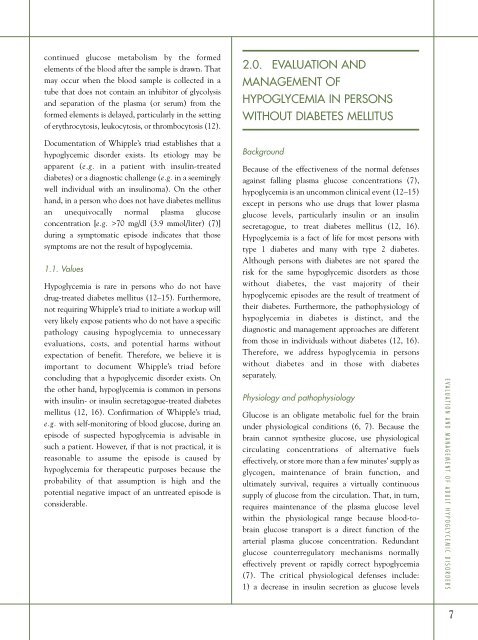Evaluation & Management of Adult Hypoglycemic Disorders
Evaluation & Management of Adult Hypoglycemic Disorders
Evaluation & Management of Adult Hypoglycemic Disorders
You also want an ePaper? Increase the reach of your titles
YUMPU automatically turns print PDFs into web optimized ePapers that Google loves.
continued glucose metabolism by the formed<br />
elements <strong>of</strong> the blood after the sample is drawn. That<br />
may occur when the blood sample is collected in a<br />
tube that does not contain an inhibitor <strong>of</strong> glycolysis<br />
and separation <strong>of</strong> the plasma (or serum) from the<br />
formed elements is delayed, particularly in the setting<br />
<strong>of</strong> erythrocytosis, leukocytosis, or thrombocytosis (12).<br />
Documentation <strong>of</strong> Whipple’s triad establishes that a<br />
hypoglycemic disorder exists. Its etiology may be<br />
apparent (e.g. in a patient with insulin-treated<br />
diabetes) or a diagnostic challenge (e.g. in a seemingly<br />
well individual with an insulinoma). On the other<br />
hand, in a person who does not have diabetes mellitus<br />
an unequivocally normal plasma glucose<br />
concentration [e.g. >70 mg/dl (3.9 mmol/liter) (7)]<br />
during a symptomatic episode indicates that those<br />
symptoms are not the result <strong>of</strong> hypoglycemia.<br />
1.1. Values<br />
Hypoglycemia is rare in persons who do not have<br />
drug-treated diabetes mellitus (12–15). Furthermore,<br />
not requiring Whipple’s triad to initiate a workup will<br />
very likely expose patients who do not have a specific<br />
pathology causing hypoglycemia to unnecessary<br />
evaluations, costs, and potential harms without<br />
expectation <strong>of</strong> benefit. Therefore, we believe it is<br />
important to document Whipple’s triad before<br />
concluding that a hypoglycemic disorder exists. On<br />
the other hand, hypoglycemia is common in persons<br />
with insulin- or insulin secretagogue-treated diabetes<br />
mellitus (12, 16). Confirmation <strong>of</strong> Whipple’s triad,<br />
e.g. with self-monitoring <strong>of</strong> blood glucose, during an<br />
episode <strong>of</strong> suspected hypoglycemia is advisable in<br />
such a patient. However, if that is not practical, it is<br />
reasonable to assume the episode is caused by<br />
hypoglycemia for therapeutic purposes because the<br />
probability <strong>of</strong> that assumption is high and the<br />
potential negative impact <strong>of</strong> an untreated episode is<br />
considerable.<br />
2.0. EVALUATION AND<br />
MANAGEMENT OF<br />
HYPOGLYCEMIA IN PERSONS<br />
WITHOUT DIABETES MELLITUS<br />
Background<br />
Because <strong>of</strong> the effectiveness <strong>of</strong> the normal defenses<br />
against falling plasma glucose concentrations (7),<br />
hypoglycemia is an uncommon clinical event (12–15)<br />
except in persons who use drugs that lower plasma<br />
glucose levels, particularly insulin or an insulin<br />
secretagogue, to treat diabetes mellitus (12, 16).<br />
Hypoglycemia is a fact <strong>of</strong> life for most persons with<br />
type 1 diabetes and many with type 2 diabetes.<br />
Although persons with diabetes are not spared the<br />
risk for the same hypoglycemic disorders as those<br />
without diabetes, the vast majority <strong>of</strong> their<br />
hypoglycemic episodes are the result <strong>of</strong> treatment <strong>of</strong><br />
their diabetes. Furthermore, the pathophysiology <strong>of</strong><br />
hypoglycemia in diabetes is distinct, and the<br />
diagnostic and management approaches are different<br />
from those in individuals without diabetes (12, 16).<br />
Therefore, we address hypoglycemia in persons<br />
without diabetes and in those with diabetes<br />
separately.<br />
Physiology and pathophysiology<br />
Glucose is an obligate metabolic fuel for the brain<br />
under physiological conditions (6, 7). Because the<br />
brain cannot synthesize glucose, use physiological<br />
circulating concentrations <strong>of</strong> alternative fuels<br />
effectively, or store more than a few minutes’ supply as<br />
glycogen, maintenance <strong>of</strong> brain function, and<br />
ultimately survival, requires a virtually continuous<br />
supply <strong>of</strong> glucose from the circulation. That, in turn,<br />
requires maintenance <strong>of</strong> the plasma glucose level<br />
within the physiological range because blood-tobrain<br />
glucose transport is a direct function <strong>of</strong> the<br />
arterial plasma glucose concentration. Redundant<br />
glucose counterregulatory mechanisms normally<br />
effectively prevent or rapidly correct hypoglycemia<br />
(7). The critical physiological defenses include:<br />
1) a decrease in insulin secretion as glucose levels<br />
EVALUATION AND MANAGEMENT OF ADULT HYPOGLYCEMIC DISORDERS<br />
7


